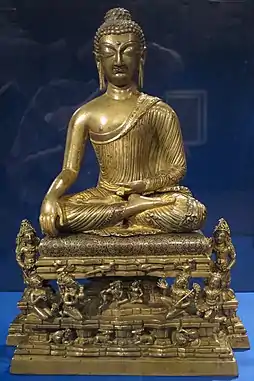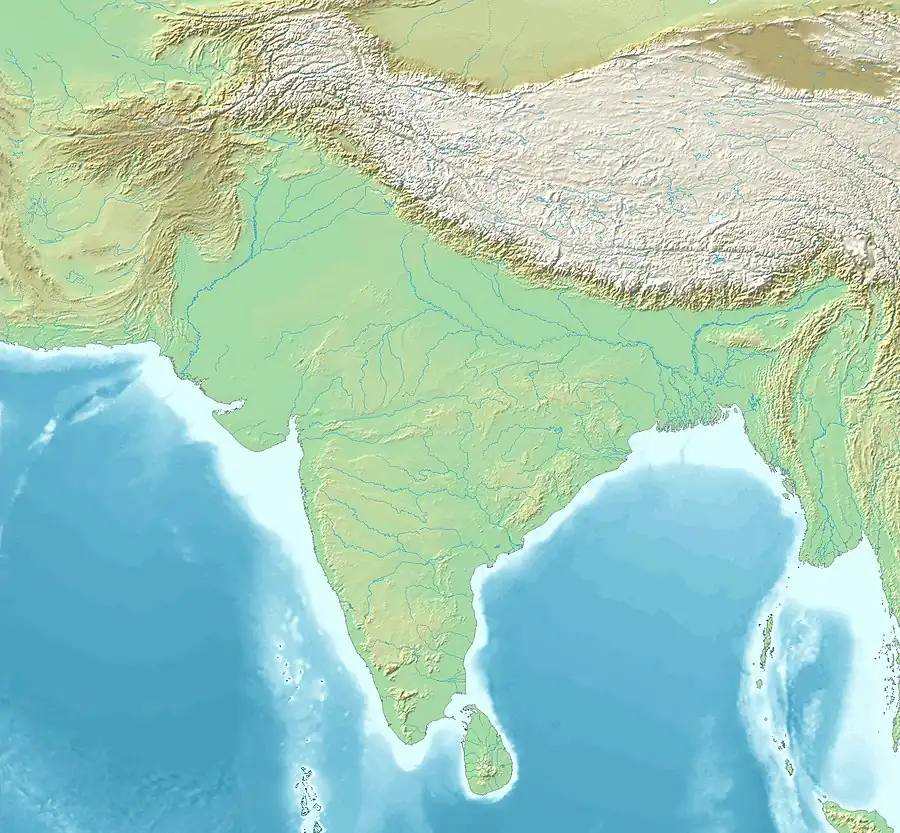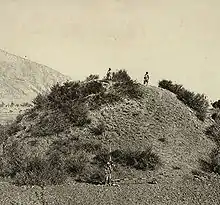Buddhism in Kashmir
Buddhism in Kashmir was once an important part of the classical Kashmiri culture, as is reflected in the Nilamata Purana and Kalhana's Rajatarangini.
Buddhism, a religion originating in the Gangetic plains of Eastern India, was introduced in Kashmir under the reign of Emperor Ashoka of the Mauryan Empire, in about 245 BCE.[1] From Kashmir, it spread to the neighbouring Ladakh, Tibet and China proper. Accounts of patronage of Buddhism by the rulers of Kashmir are found in the Rajatarangini and also in the accounts of three Chinese visitors to Kashmir during 630-760 AD.[2]
Origins
Hinduism is the oldest recorded religion practiced by the Kashmiri people.[3][4][5] Prior to the arrival of Buddhism, Shaivite Hinduism was the predominant religion in Kashmir, and Kashmir was a symbol of Brahminical rule in Northern India.[4][3][5]
Although Buddhism originated in the Gangetic plains of Eastern India, it was introduced in the Kashmir Valley under the reign of Emperor Ashoka of the Mauryan Empire, in about 245 BCE.[1] During the reign of Ashoka (304–232 BCE), Buddhism eventually became dominant and Hinduism started declining as a major religion in Kashmir.[6][4]
Buddhist sources attribute the first induction of Buddhism in Kashmir, dating to 245 BCE, to a monk of Varanasi, Majjhantika, who was also a disciple of Ananda. According to the Ceylonese Chronicle, after the conclusion of the Third Buddhist Council, Mauryan emperor, Ashoka sent missionaries across countries to spread Buddhism. Majjhantika was sent to Kashmir and Gandhara (modern day Afghanistan). The story of Majjhantika is also told in several other Buddhist texts such as the Ashokavadana and Avadanakalpalata. However the Buddhist text Divyavadana states that several monks from Kashmir were invited by Ashoka to Patliputra (present day Patna, Bihar).[7]
After Ashoka's death, Buddhism declined and Brahminical Hinduism was revived in Kashmir again.[1]
Mauryan period
Ashoka
Buddhism was introduced in Kashmir under the reign of Emperor Ashoka of the Mauryan Empire, in about 245 BCE.[1] King Ashoka settled 5000 Buddhist monks from the Gangetic plains in Kashmir to proselytise Buddhism and dilute the presence of the predominant Brahminical Hinduism in the region.[8][5]
Kalhana's in his 12th century historical chronicle Rajatarangini, mentioned another king Ashoka (Gonandiya) of Kashmir as a devout Buddhist who built many stupas[9][10] and Shiva temples.[10] The provincial capital Srinagar, which he established, was 'resplendent with prosperity and wealth.'[10]
According to some Buddhist writers including Taranatha, the Buddhist preacher Madhyantika introduced saffron cultivation into Kashmir. Buddhism and Shaivism flourished side by side in Kashmir during Ashoka's time and received the Emperor's patronage in equal measure. Kalhana notes that Ashoka built two Shiva temples at Vijayeshvara (Bijbehara), and ordered several others renovated. In Vitastatra (Vethavutur) and at Shuskaletra (Hukhalitar) he built a number of viharas and stupas.
Ashoka's successors
Buddhism suffered a temporary eclipse during the reign of Ashoka's successors Jalauka and Damodara. Kalhana, asserted that a large number of Buddhist scholars were vanquished in debates with Jalauka's guru Avadhuta, and hence traditional observances were slowly revived. Later, however, Jalauka created a big vihāra, the Krityashramavihara in the vicinity of Varahamula (Baramulla), which still existed as late as the 11th century. The history of Kashmir after Damodara is not certain until the time of the Kushanas.
Kushana period
The Kushan period saw a resurgence of Buddhism in Kashmir upto some extent, especially during the reign of Kanishka.[1] The fourth Buddhist Council was held in Kashmir, under the presidency of Katyayaniputra, in Kanishka's time. The south Indian Buddhist philosopher, Nagarjuna lived in Kashmir during the Kushana period.
After the end of the Kushan period, Buddhism majorly declined in the region again, with Hinduism once again gaining majority.[1]
Alchon Hun period

Buddhism is stated by Kalhana and Hiuen Tsang to have suffered severe setbacks and violent persecution under the Alchon Huns, especially under King Mihirakula, whom Hiuen Tsang describes as a great persecutor of the Buddhists.[12][13] Mihirakula's persecution resulted in Buddhism collapsing in Kashmir and rest of northwestern Indian subcontinent,[13][12] and also the dominance of Hinduism in the region as the majority religion again, due to preference given to its proselytisation.[14][12]
Meghavahana
Upon Mihirakula's death, Kashmir was ruled by Meghavahana, who belonged to the old ruling dynasty of Kashmir. Meghavahana was a staunch Buddhist, who issued a proclamation against killing of all animals at the very time of his coronation, and built numerous stupas.
Xuanzang in Kashmir
The Chinese Buddhist monk Xuanzang, who visited the region in the years 630–644, said that Buddha wasn't revered by the people of Kashmir, with almost all most monasteries being reduced to ruins after Mihirakula's persecution.[13][12][15] Whereas thousands of Hindu Shaivite temples were found in Kashmir.[16][15] Several centuries later, Hinduism was the predominant religion of Kashmir at the time of the arrival of Islam.[8]
Buddhist influence in Kashmir

Hinduism and Buddhism, had existed side by side in Kashmir for centuries, ever since the introduction of Buddhism in the region, although Hinduism was the predominant religion for majority of the time.[1]
In Kalhana's time, and before, there was apparently no distinction between "Hindus" and Buddhists in Kashmir. Kalhana himself used Buddhist terms and expressions as a Buddhist would.
Nilamata Purana was the text of the worshippers of Nila Naga; Naga worship was common in Kashmir. It mentions the prevalence of Buddhist worship in Kashmir.
Here are some quotes from Nilamat Purana from Kashmir (trans. by Dr. Ved Kumari) (link below). It correctly represents the religious spirit of ancient India.
709-710a. O Brahman, the god Visnu, the lord of the world, shall be (born as) the preceptor of the world, Buddha by name, at the time when the Pusya is joined with the moon, in the month of Vaisaksha, in twenty eighth Kali Age.
710b-12. Listen from as to how his worship should be performed in the bright-half, from that period onwards, in future. The image of Buddha should be bathed (with water rendered holy) with all medicinal herbs, all jewels and all scents, in accordance with the sayings of the Sakyas. The dwellings of the Sakyas (i.e. Viharas) should be whitewashed with care.
713. Here and there, the Caityas - the abodes of the god - should be provided with paintings. The festival, swarming with the actors and the dancers, should be celebrated.
714. The Sakyas should be honoured with Civara (the dress of a Buddhist mendicant), food and books. All this should be done till the advent of Magha.
715. O twice-born, eatable offerings should be made for three days. Worship with flowers, clothes etc. and charity for the poor (should continue for three days).
Kalhana's Rajatarangini mentions that a monumental metallic image of Buddha once stood in Srinagar, which was eventually destroyed by Sikandar Butshikan. A significant number of beautifully crafted Buddhist bronzes have survived.
A Buddhist bhikshu was present in Baramulla in the 13th century. The Kashmiri Pandits still worship the triratna symbol.
Fazl writes, "The third time that the writer accompanied His Majesty to the delightful valley of Kashmir, he met a few old men of this persuasion (Buddhism), but saw none among the learned."[17]
Buddhist art
Kashmir was a major center of Buddhist art, and there is evidence of significant influence of Kashmir style on 11-13th century Tibetan art.[18]
While Buddhism is now extinct in the valley of Kashmir, masterpieces of Buddhist art from Kashmir are present in many museums.
See also
References
- The Encyclopaedia Britannica- A Dictionary of Arts, Sciences, and General Literature · Volume 14. A & C Black. 1882. p. 13. Retrieved September 25, 2023.
In the time of Asóka, about 245 B.C., one of the Indian Buddhist missions was sent to Kashmir and Gandhara. After his death, Brahmanism revived. Then in the time of the three Tartar princes, Hushka, Jushka, and Kanishka, who reigned in Kashmir immediately before, and in the beginning of the Christian era, Buddhism was to a great extent restored. The kingdom of Kanishka (called also Kanerkes), included the Punjab and Cabul, as well as Kashmir. Buddhism again declined, though for several centuries the two religions existed together in Kashmir, Hinduism predominating.
- Funayama, T., 1994, “Remarks on Religious Predominance in Kashmir: Hindu or Buddhist”, in Y. lkari (ed.), A Study of the Nilamata, Kyoto.
- Snedden, Christopher (2015). Understanding Kashmir and Kashmiris. Hurst Publishers. p. 27. ISBN 9781849043427. Retrieved September 30, 2023.
Before Buddhism, Kashmiris engaged in a range of Aryan-inspired religious practices which arose from Sanatana Dharma (the eternal law or way) and which practices now might be labelled 'Vedic' or 'Hindu'. Post-Buddhism, Kashmir was the home of Kashmiri Shaivism (or Trika- Shasana, Trika-Shastra, Trika), a set of monistic beliefs based on merging oneself in Shiva (or universal consciousness), the god of choice of many Kashmiri Hindus.
- "The Early History of Islam in Kashmir". Egypt Today. June 24, 2017. Archived from the original on November 17, 2018. Retrieved September 30, 2023.
About 300 BCE, Buddhism arrived in Kashmir from further south in India and started to flourish in the region. Before this, Hinduism (of some form) had been the predominant religion in Kashmir for centuries. .... It did not not take long for Kashmir, then, to become a symbolic White House of Brahminical rule in northern India.
- Bamzai, Prithivi Nath Kaul (1994). Culture and Political History of Kashmir, Volume 2. M.D. Publications Pvt. Ltd. ISBN 9788185880310. Retrieved October 3, 2023.
…Saivism must have been the predominant religion in Kashmir long before Buddhism was introduced there. (Page 200) .... The first noteworthy mass immigration took place when Emperor Asoka brought 5,000 Buddhist monks and settled them in Kashmir to popularise the Hinayana Buddhism in Kashmir and adjacent territories. (Page 61)
- Ahmad, Khalid Bashir (June 23, 2017). Kashmir: Exposing the Myth Behind the Narrative. SAGE Publications. p. 11. ISBN 9789386062819. Retrieved September 30, 2023.
When Hinduism was declining as the faith of people in Kashmir, the teachings of Gautama the Buddha received universal acceptance across the length and breadth of the country. Kashmir became one of the most important centres for the spread and development of the new faith. It is generally believed that Buddhism became dominant in Kashmir during the reign of Emperor Ashoka (3rd century BC).
- Warikoo, Kulbhushan (2009). Cultural Heritage of Jammu and Kashmir. Pentagon Press. ISBN 978-81-8274-376-2.
- Kaw, M.K. (2004). Kashmir and Its People: Studies in the Evolution of Kashmiri Society. A.P.H. Publishing Corporation. p. 182. ISBN 9788176485371. Retrieved October 7, 2023.
Here we may recall that as far back as we go into the historical past, Kashmiris have been all Hindus. Buddhism came to Kashmir with the visit of Emperor Ashoka (273-232 B.C.) with 5000 Buddhist monks who were settled here. Buddhism flourished in Kashmir for centuries especially under the Kushan kings and reached a high point in emperor Kanishka's (1st century A.D.) time. But with the decline of Buddhismin the rest of India it declined and Hinduism saw great revival. In any case during the reign of Hindu Kings Buddhism survived along with Hinduism and even received royal patronage at various stages e.g. the great and mighty king Lalitaditya built temples for the Buddha along with those for Shiva, Vishnu & other Hindu gods. But eventually Buddhism lost its following in the Valley.
- Sen, Sailendra Nath (1999). Ancient Indian History and Civilization. New Age International. p. 152. ISBN 978-81-224-1198-0.
- Pandit, Ranjit Sitaram (1935). River Of Kings (rajatarangini). p. 17, Note 102.
- "Metropolitan Museum of Art". www.metmuseum.org.
- Doniger, Wendy (1999). Merriam-Webster's Encyclopedia of World Religions. Merriam-Webster. pp. 155–157. ISBN 978-0-87779-044-0.
- McNair, Amy (2007). Donors of Longmen. University of Hawaiʻi Press. p. 89. ISBN 9780824829940. Archived from the original on April 22, 2023. Retrieved October 21, 2023.
... and the destruction of Buddhist establishment in Northwest India by the Hephthalite invader, Mihirakula (502-542) in the early sixth century.
{{cite book}}: CS1 maint: bot: original URL status unknown (link) - Fogelin, Lars (2015). An Archaeological History of Indian Buddhism. Oxford University Press. p. 149. ISBN 9780199948239.
...the emergence and spread of Hinduism through Indian society helped lead to Buddhism's gradual decline in India.
- Heinz, Carolyn Brown; A. Murray, Jeremy (1999). Asian Cultural Traditions. Waveland Press. p. 208. ISBN 9781478637646. Archived from the original on June 26, 2021. Retrieved October 21, 2023.
Three hundred years later, another Chinese monk named Xuanzang made much the same journey, but now things had changed. Buddhism was in retreat. Many shrines were in ruins, and in Kashmir and Bengal Buddhists were being persecuted. Xuanzang wrote of his grief at the empty spaces where Buddha had once taught, evidence that Buddhism was going into decline.
- Shu Hikosaka, G. John Samuel, Can̲ārttanam Pārttacārati (ed.), Buddhist themes in modern Indian literature, Inst. of Asian Studies, 1992, p. 268
- Kishori Saran Lal (1999). Theory and Practice of Muslim State in India. Aditya Prakashan. p. 110.
- Kashmir and the Tibetan Connection, Pal, Pratapaditya, Marg, Vol. 40 No. 2, March 1987, pp. 57-75
- Ganhar et al., Buddhism in Kashmir and Ladakh, Tribune Press, New Delhi, 1956
- Kaul, Advaitavadini,Buddhist Savants of Kashmir - Their Contributions Abroad, Utpal Publications,Srinagar,1987
- Kaul, Advaitavadini, Buddhism in Kashmir, Indologica Taurinensia 31, 159–171, 2005
- Rizvi, J. Trans-Himalayan Caravans, Oxford India Paperbacks, 1999.
- Kalhana's Rajatarangini, A Chronicle of the Kings of Kashmir, M.A. Stein, 2 vols. London, 1900.
- The Patola Shahi dynasty : a Buddhological study of their patronage, devotion and politics, Rebecca L. Twist, PhD Thesis, The Ohio State University 2008.
External links
- Nilamata Purana, trans. Ved Kumari
- Kashmiri Buddha bronze (c. 644 - 654), inscribed in the reign of king Narasurendea
- Crowned Buddha Shakyamuni 8th century
- The Gilgit Manuscript



